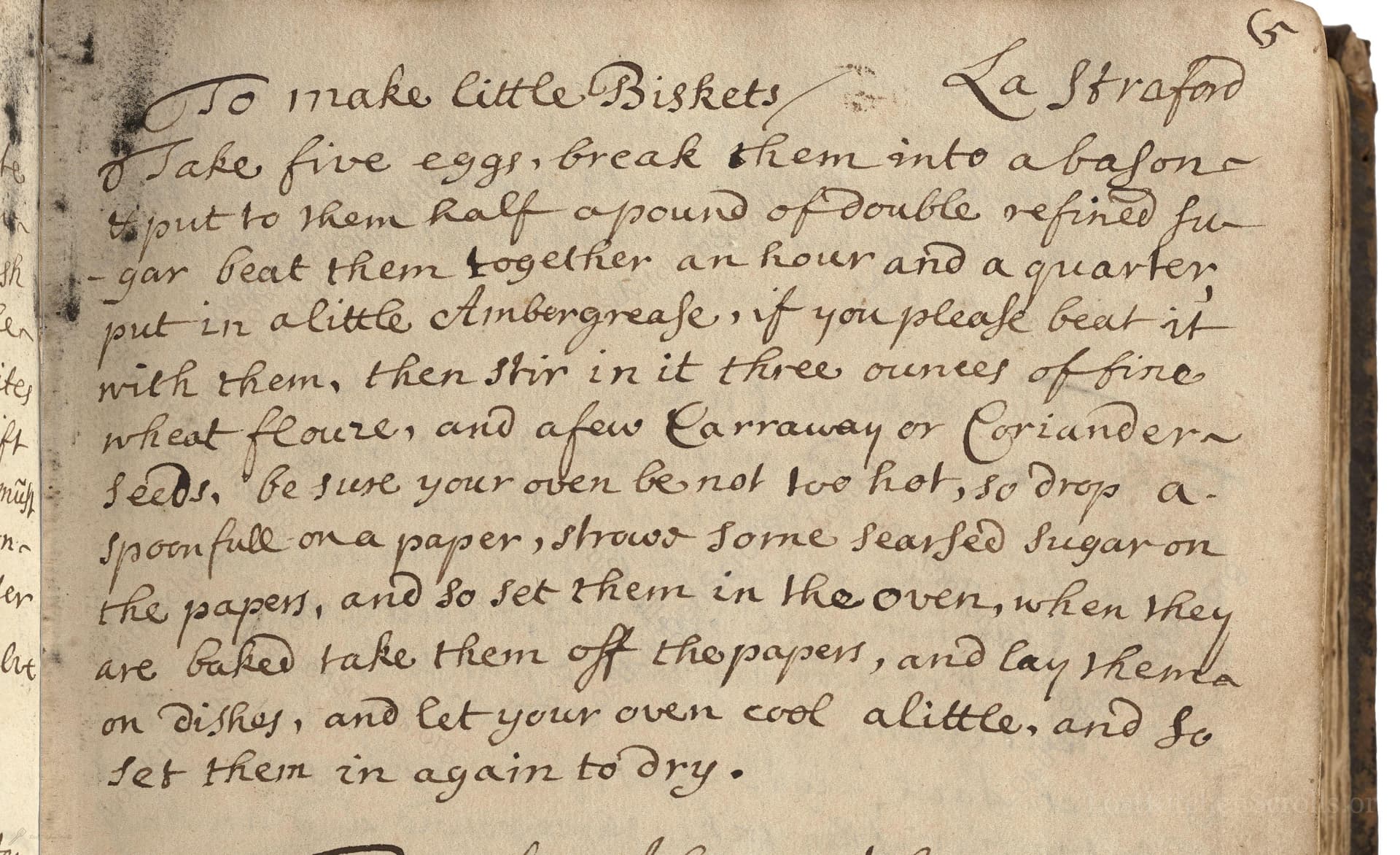To Make Little Biskets La Staford
From the treasured pages of Cookbook
Unknown Author

To Make Little Biskets La Staford
"Take five eggs, break them into a bason & put to them half a pound of double refined sugar beat them together an hour and a quarter, put in a little Ambergrease, if you please beat it with them, then stir in it three ounces of fine wheat floure, and a few Carraway or Coriander seeds, be sure your oven be not too hot, so drop a spoonfull on a paper, strow some searced sugar on the papers, and so set them in the oven, when they are baked take them off the papers, and lay them on dishes, and let your oven cool a little, and so set them in again to dry."
Note on the Original Text
The language of this recipe is typical of the early 1700s: spelling was variable ('bason' for basin, 'floure' for flour), instructions were conversational, and exact timing or measurements were rare. Note the extended whisking time—borne out by hand-powered techniques. Ambergrease (ambergris) is a now rarely used perfume ingredient, once prized for its mysterious aroma; edible substitutions or omissions are acceptable. The recipe's structure assumes basic cookery skills, and the use of 'a little' or 'some' reflects an intuitive, rather than codified, approach.

Title
Cookbook (1706)
You can also click the book image above to peruse the original tome
Writer
Unknown
Era
1706
Publisher
Unknown
Background
Step back to the early 18th century with this charming culinary collection, brimming with period recipes that tantalize the tastebuds and offer a delicious glimpse into historic kitchens.
Kindly made available by
Folger Shakespeare Library
This delightful recipe for 'little Biskets La Staford' hails from around 1706 in England—a time when sugar was a luxury, and biscuits were more about delicate nibbles than the hearty cookies we know today. Recipes like this were often made in aristocratic households for special occasions or as dainties to accompany tea and coffee, both of which were fashionable and newly popular. The inclusion of exotic ingredients like ambergris reflects the status and adventurous palate of the well-heeled cooks of the time. These biskets sit at the intersection of a meringue and a sponge, capturing the lightness prized in 18th-century confections.

Cooks in the early 18th century would have used a deep ceramic or pewter basin for beating the eggs and sugar—wooden spoons or rods were the usual beating implements (sometimes a sprig of birch as an early whisk!). The batter would be spooned onto sheets of oiled or floured paper, laid on iron baking sheets. Baking was done in a brick oven, with considerable skill required to judge the temperature—no thermometers! A fine sieve would be used for flour, and sugar sifted on top for a crisp finish.
Prep Time
20 mins
Cook Time
25 mins
Servings
20
We've done our best to adapt this historical recipe for modern kitchens, but some details may still need refinement. We warmly welcome feedback from fellow cooks and culinary historians — your insights support the entire community!
Ingredients
- 5 large eggs
- 8 oz caster sugar (double refined sugar)
- Pinch edible ambergris (optional, or substitute a drop of orange blossom water or omit)
- 3 oz plain wheat flour (all-purpose flour)
- 1 tsp caraway seeds or lightly crushed coriander seeds
- Extra caster sugar for sprinkling
Instructions
- Begin by cracking 5 large eggs into a mixing bowl.
- To these, add 8 ounces of finely ground caster sugar (double refined sugar).
- Whisk them together vigorously for about 75 minutes with a stand mixer, or until the mixture is light, thick, and pale—this long whisk is essential to capture the old-fashioned airy texture.
- If you can source edible ambergris, add a pinch; otherwise, use a drop of orange blossom water or leave it out.
- Sieve in 3 ounces of plain wheat flour (all-purpose flour) and gently fold to combine.
- Mix in a teaspoon of caraway seeds or lightly crushed coriander seeds, as desired.
- Preheat your oven to 300°F (fan 265°F), ensuring it is not too hot.
- Line a baking tray with parchment paper and drop spoonfuls of the batter onto it, spacing them apart.
- Dust the tops gently with extra sifted caster sugar.
- Bake for about 12–15 minutes, or until lightly golden at the edges.
- Peel the biscuits from the paper, transfer to dishes, and allow the oven to cool slightly.
- Return the biscuits to the now-cooler oven for a further 10 minutes to dry them out, as was traditional for a crisp finish.
Estimated Calories
60 per serving
Cooking Estimates
It takes about 20 minutes to prepare the ingredients and batter, and you'll need to whisk the eggs and sugar for a long time to get the right airy texture. Cooking in the oven takes around 25 minutes in total. Each biscuit has about 60 calories, and this recipe makes about 20 biscuits.
As noted above, we have made our best effort to translate and adapt this historical recipe for modern kitchens, taking into account ingredients nowadays, cooking techniques, measurements, and so on. However, historical recipes often contain assumptions that require interpretation.
We'd love for anyone to help improve these adaptations. Community contributions are highly welcome. If you have suggestions, corrections, or cooking tips based on your experience with this recipe, please share them below.
Join the Discussion
Rate This Recipe
Dietary Preference
Occasions

Den Bockfisch In Einer Fleisch Suppen Zu Kochen
This recipe hails from a German manuscript cookbook compiled in 1696, a time whe...

Die Grieß Nudlen Zumachen
This recipe comes from a rather mysterious manuscript cookbook, penned anonymous...

Ein Boudain
This recipe comes from an anonymous German-language manuscript cookbook from 169...

Ein Gesaltzen Citroni
This recipe, dating from 1696, comes from an extensive anonymous German cookbook...
Browse our complete collection of time-honored recipes



